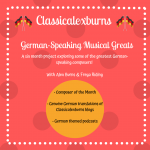Ludwig van Beethoven: Piano Trio in D Major ‘Ghost’
Context
Ludwig van Beethoven’s set of two piano trios under Opus. 70 were composed during the composer’s stay at Countess Marie von Erdödy’s estate. Both of the trios are dedicated to the Countess, and were published in 1809.
The first trio, also known as the Ghost Trio has become one of the favourites in the repertoire. The trio features themes that Beethoven then used for his Second Symphony. The trio has been described as:
“A strangely scored and undeniably eerie-sounding slow movement, it was dubbed the ‘Ghost Trio’. The name has stuck with the work ever since. The ghostly music may have had its roots in sketches for a Macbeth opera that Beethoven was contemplating at the time.”
The origin of the nickname is said to come from Beethoven’s then pupil Carl Czerny, who wrote in 1842 that the slow movement reminded him of the ghost scene at the opening of Shakespeard’s Hamlet.
Both of the trios in Op.70 are representative of Beethoven’s ‘Middle-Period’ of works. During this time Beethoven had recently composed his Fifth Symphony, and was working on his Sixth. His creativity was at all an all time high during this period, with many of the works he composed remaining incredibly popular today.
The Music
Movement I – Allegro vivace e con brio
Opening with a triumphant unison figure, the main theme of the movement is played within the first few bars. The style is direct, which gives an arched shape to the movement making it more succinct. Beethoven does this with the first and third movements as the second is the most developmental.
The imitative nature of this movement is showcased through the sheer communication between the three parts. The strings in particular offer a colourful call and response sequence that is aptly accompanied by the piano near the start.
The music is vivacious and the bold unison sections make a real dynamic impact. The theme is passed around all three parts and developed over the course of the movement. Near the end the tempo and dynamics begin to drop to build tension before an unusually slow section ensues. This soon passes before the triumphant end to the movement sees all three instruments unite once more.
Movement II – Largo es assai expressivo
The extensive slow second movement is introduced with an eerie sustained sequence of chords. The mournful piano moves along with the strings, however the music is heavy and is held back ever so slightly. The darkness of the D minor tonality shines throughout this movement, with the ominous mood taking centre stage.
Beethoven moves into C major as he begins the development section. This adds a sense of hope to the music, before it is taken away again. Beethoven then explores the theme from a number of other keys, which not only develops the theme, but also expresses his penchant for gripping harmonic language. The changing of keys also builds the tension back up that was lost slightly when the C major section happened.
The end of the movement is perhaps the most gripping part. Littered with pauses and abrupt stops and outbursts, this ghostly second movement is effective in so many ways. The ghost atmosphere is created by culminating slow crescendos and diminuendos, using eerie chromaticism and utilising silence as much as notes. The movement is one of Beethoven’s most celebrated piece of writing, and you can absolutely see why.
Movement III – Presto
The third and final movement of this trio opens with perky phrase by the piano which is soon accentuated by the strings. The bright and lucid writing of the third movement opposes the ominous and mysterious writing of the previous movement. The sharp contrasts in dynamics and phrasing adds to the impact of this final movement.
The seamless transitions into each section are intriguing and highlight Beethoven’s complex writing for a chamber group. During his ‘Middle-Period’, Beethoven began experimenting with how far he could push chamber ensembles. The tight writing that perfectly interlocks with one another is difficult for the performers to get the balance right. The ending showcases the players as virtuosos as the pizzicato section bursts into a short reprise of the opening until the trio unites back in the home key.
Final Thoughts
Ludwig van Beethoven’s highly illustrative ‘Ghost Trio’ has remained one of his most celebrated chamber works. From the sparkling outer movements to the eerie second movement, the trio is a great celebration of the piano trio as an ensemble.
Ⓒ Alex Burns
Happy Reading!
You might also enjoy… Ruth Schönthal: String Quartet No.3
*This blog is part of the German Speaking Musical Greats Project 2019/20

Recommended Recordings:


0 Comments